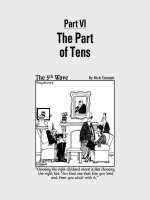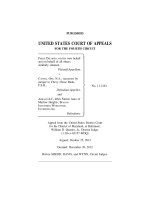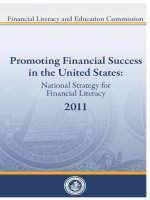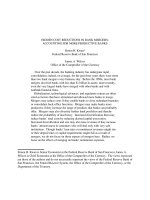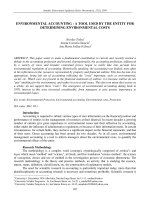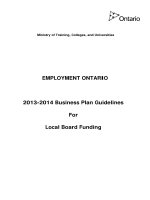Tips for Bargaining at Markets_8 docx
Bạn đang xem bản rút gọn của tài liệu. Xem và tải ngay bản đầy đủ của tài liệu tại đây (628.25 KB, 21 trang )
196 Chapter 10. The Role of Anonymity
examination the assumption that agents discount future payoffs, when com-
bined with the other as sumptions of the model, is not as natural as it seems.
The fact that agents discount the future not only makes a delay in reach-
ing agreement costly; the key fact in this model is that it makes holding
a spe cial relationship costly. A buyer and a seller who are matched are
forced to separate at the end of the bargaining session even if they have a
special “personal relationship”. The chance that they will be reunited is
the same as the chance that each of them will meet another buyer or seller.
Thus there is a “tax” on personal relationships, a tax that prevents the
formation of such relationships in equilibrium. It seems that this tax does
not capture any realistic feature of the situations we observe.
We now try to separate the two different roles that discounting plays in
the model. Remove the assumption that pairs have to separate at the end
of a bargaining session; assume instead that each partner may stay with
his current partner for another period or return to the pool of agents wait-
ing to b e matched in the next period. Supp ose that the agents make the
decision whether or not to stay with their current partner simultaneously.
These assumptions do not penalize personal relationships, and indeed the
results show that noncompetitive prices are consistent with subgame per-
fect equilibrium.
The model is very similar to that of Section 9.4.2. Here the proposer
is selected randomly, and the seller may switch buyers at the beginning of
each period. In the model of Sec tion 9.4.2 the agents take turns in making
prop os als and the seller may switch buyers only at the beginning of a period
in which her partner is scheduled to make an offer. The important feature
of the model here that makes it similar to that of Section 9.4.2 rather than
that of Section 9.4.1 is that the seller is allowed to leave her partner after
he rejects her offer, which, as we saw, allows the seller to make what is
effectively a “take-it-or-leave-it” offer.
As in Section 9.4.2 we can construct subgame perfect equilibria that
support a wide range of prices. Suppose for simplicity that there is a single
seller (and an arbitrary numb e r B of buyers). For every p
∗
s
such that
p
s
(1) ≤ p
∗
s
≤ p
s
(B) we can construct a subgame perfect equilibrium in
which immediate agreement is reached on either the price p
∗
s
, or the price
p
∗
b
satisfying p
∗
b
= δ(p
∗
s
+ p
∗
b
)/2, depending on the selection of the first
prop os er. In this equilibrium the seller always proposes p
∗
s
, accepts any
price of p
∗
b
or more, and stays with her partner unless he rejected a price
of at most p
∗
s
. Each buyer proposes p
∗
b
, accepts any price of p
∗
s
or less, and
never abandons the seller.
Recall that p
s
(1) (which depends on δ) is the offer made by the seller
in the unique subgame perfect equilibrium of the game in which there is a
single buyer; p
s
(B) is the offer made by the seller when there are B buyers
10.5 Market Equilibrium and Competitive Equilibrium 197
and partners are forced to separate at the end of each period. The limits
of p
s
(1) and p
s
(B) as δ converges to 1 are 1/2 and 1, resp e ctively. Thus
when δ is close to 1 almost all prices between 1/2 and 1 can be supported
as subgame perfect equilibrium prices.
Thus when partners are not forced to separate at the end of each period,
a wide range of outcomes—not just the competitive one—can be supported
by market equilibria even if agents discount the future. We do not claim
that the model in this section is a good model of a market. Moreover,
the set of outcome s predicted by the theory includes the competitive one;
we have not ruled out the possibility that another theory will isolate the
competitive outcome. However, we have shown that the fact that agents
are impatient does not automatically rule out noncompetitive outcomes
when the other elements of the model do not unduly penalize “personal
relationships”.
10.5 Market Equilibrium and Competitive Equilibrium
“Anonymity” is sometimes stated as a condition that must be satisfied in
order for an application of a competitive model to be reasonable. We have
explored the meaning of anonymity in a model in which agents mee t and
bargain over the terms of trade. As Proposition 8.2 shows, when agents are
anonymous, the only market equilibrium is competitive. When agents have
sufficiently detailed information about events that occurred in the past and
recognize their partners, then noncompetitive outcomes can emerge, even
though the matching process is anonymous (agents are matched randomly).
The fact that this result is sensitive to our assumption that there is no
discounting can be attributed to other elements of the model, which inhibit
the agents’ abilities to form special relationships. In our models, matches
are random, and partners are forced to separate at the end of each period.
If the latter assumption is modified, then we find that once again special
relationships can emerge, and noncompetitive outcomes are possible.
We do not have a theory to explain how agents form special relationships.
But the results in this chapter suggest that there is room for such a theory
in any market where agents are not anonymous.
Notes
This chapter is based on Rubinstein and Wolinsky (1990).
References
The numbers in brackets after each reference are the page numbers on which the reference
is cited. The hyperlinks lead to reviews of the items on the American Mathematical
Society’s MathSciNet. Depending on the services to which your institution subscribes,
the page containing a review may contain also a link that allows you to check the
availability of the item in your institution’s library.
Admati, A. R., and M. Perry (1987), “Strategic Delay in Bargaining”,
Review of Economic Studies 54, 345–364. [119]
Admati, A. R. and M. Perry (1991), “Joint Projects without Commitment”,
Review of Economic Studies 58, 259–276. [67]
Anbarci, N. (1993), “Noncooperative Foundations of the Area Monotonic
Solution”, Quarterly Journal of Economics 108, 245–258. [90]
Aumann, R. J. (1959), “Acceptable Points in General Cooperative n-Person
Games”, pp. 287–324 in A. W. Tucker and R. D. Luce (eds.), Con-
tributions to the Theory of Games, Vol. IV, Princeton University
Press. [65]
Ausubel, L. M., and R. J. Deneckere (1989a), “Reputation in Bargaining
and Durable Goods Monopoly”, Econometrica 57, 511–531. [106]
Ausubel, L. M. and R. J. Deneckere (1992a), “Durable Goods Monopoly
with Incomplete Information”, Review of Economic Studies 59, 187–
203. [119]
199
200 References
Ausubel, L. M. and R. J. Deneckere (1992b), “Bargaining and the Right
to Remain Silent”, Econo metrica 60, 597–625. [119]
Baron, D. P., and J. A. Ferejohn (1987), “Bargaining and Agenda Forma-
tion in Legislatures”, American Economic Review 77 (Papers and
Proceedings), 303–309. [67]
Baron, D. P., and J. A. Ferejohn (1989), “Bargaining in Legislatures”,
American Political Science Review 83, 1181–1206. [67]
Bester, H. (1988a), “Bargaining, Search Costs and Equilibrium Price Dis-
tributions”, Review of Economic Studies 55, 201–214. [188]
Bester, H. (1988b), “Qualitative Uncertainty in a Market with Bilateral
Trading”, Scandinavian Journal of Economics 90, 415–434. [187]
Bester, H. (1989a), “Noncooperative Bargaining and Spatial Competition”,
Econometrica 57, 97–113. [188]
Bester, H. (1989b), “Non-Cooperative Bargaining and Imperfect Competi-
tion: A Survey”, Zeitschrift f¨ur Wirtschafts- und Sozialwissenschaf-
ten 109, 265–286. [6]
Bikhchandani, S. (1986), “A Bargaining Model with One-Sided Incomplete
Information about Reservation Prices”, unpublished paper, Grad-
uate School of Management, University of California, Los Angeles.
[119]
Bikhchandani, S. (1992), “A Bargaining Model with Incomplete Informa-
tion”, Review of Economic Studies 59, 187–203. [119]
Binmore, K. G. (1985), “Bargaining and Coalitions”, pp. 269–304 in Roth
(1985). [65, 187]
Binmore, K. G. (1987a), “Nash Bargaining Theory II”, pp. 61–76 in Bin-
more and Dasgupta (1987). [65, 89, 90]
Binmore, K. G. (1987b), “Perfect Equilibria in Bargaining Models”, pp. 77–
105 in Binmore and Dasgupta (1987). [54, 66]
Binmore, K. G. (1987c), “Nash Bargaining and Incomplete Information”,
pp. 155–192 in Binmore and Dasgupta (1987). [90]
Binmore, K. G., and P. Dasgupta (1987), The Economics of Bargaining,
Oxford: Blackwell.
Binmore, K. G., and M. J. Herrero (1988a), “Matching and Bargaining in
Dynamic Markets”, Review of Economic Studies 55, 17–31. [136,
170, 171]
Binmore, K. G., and M. J. Herrero (1988b), “Security Equilibrium”, Review
of Economic Studies 55, 33–48. [148]
Binmore, K. G., M. J. Osborne, and A. Rubinstein (1992), “Noncooperative
Models of Bargaining”, pp. 179–225 in R. J. Aumann and S. Hart
(eds.), Handbook of Game Theory with Economic Applications (Vol-
ume 1), Amsterdam: North-Holland. [6]
References 201
Binmore, K. G., A. Rubinstein, and A. Wolinsky (1986), “The Nash Bar-
gaining Solution in Economic Modelling”, Rand Journal of Eco-
nomics 17, 176–188. [90]
Binmore, K. G., A. Shaked, and J. Sutton (1989), “An Outside Option
Experiment”, Quarterly Journal of Economics 104, 753–770. [65]
Bulow, J., and K. Rogoff (1989), “A Constant Recontracting Model of
Sovereign Debt”, Journal of Political Economy 97, 155–178. [67]
Butters, G. R. (1977), “Equilibrium Price Distributions in a Random Meet-
ings Market”, unpublished paper, Princeton University. [136]
Carlsson, H. (1991), “A Bargaining Model where Parties Make Errors”,
Econometrica 59, 1487–1496. [90]
Casella, A., and J. S. Feinstein (1990), “Economic Exchange during Hy-
perinflation”, Journal of Political Economy 98, 1–27. [188]
Casella, A., and J. S. Feinstein (1992), “A Note on Bargaining and Infla-
tion”, Economics Letters 38, 393–398. [188]
Chae, S., and J A. Yang (1988), “The Unique Perfect Equilibrium of an
N-Person Bargaining Game”, Economics Letters 28, 221–223. [67]
Chatterjee, K., B. Dutta, D. Ray, and K. Sengupta (1993), “A Non-
Cooperative Theory of Coalitional Bargaining”, Review of Economic
Studies 60, 463–477. [67]
Chatterjee, K., and L. Samuelson (1987), “Bargaining with Two-sided In-
complete Information: An Infinite Horizon Model with Alternating
Offers”, Review of Economic Studies 54, 175–192. [120]
Chatterjee, K., and L. Samuelson (1988), “Bargaining under Two-Sided
Incomplete Information: The Unrestricted Offers Case”, Operations
Research 36, 605–618. [119]
Chatterjee, K. and L. Samuelson (1990), “Perfect Equilibria in Simultan-
eous-Offers Bargaining”, International Journal of Game Theory 19,
237–267. [67]
Chikte, S. D. and S. D. Deshmukh (1987), “The Role of External Search
in Bilateral Bargaining’, Operations Research 35, 198–205. [67]
Cho, I K. (1989), “Characterization of Stationary Equilibria in B argaining
Models with Incomplete Information”, unpublished paper, Depart-
ment of Economics, University of Chicago. [119]
Cho, I K., and D. M. Kreps (1987), “Signaling Games and Stable Equilib-
ria”, Quarterly Journal of Economics 102, 179–221. [107, 112]
Clemhout, S., and H. Y. Wan, Jr. (1988), “A General Dynamic Model
of Bargaining—The Perfect Information Case”, pp. 293–305 in Ad-
vances in Optimization and Control (H. A. Eiselt and G. Pederzoli,
eds.), Springer-Verlag, Berlin. [67]
Cothren, R., and M. A. Loewenstein (n.d.), “Quality Signals and Asym-
metric Information in a Sequential Bargaining Game”, unpublished
202 References
paper, Virginia Polytechnic Institute and State University. [119]
Cramton, P. C. (1992), “Strategic Delay in Bargaining with Two-Sided
Uncertainty’, Review of Economic Studies 59, 205–225. [119]
Dasgupta, P., and E. S. Maskin (1989), “Bargaining and Destructive
Power”, Discussion Paper 1432, Harvard Institute of Economic Re-
search, Harvard University. [90]
Davidson, C. (1988), “Multiunit Bargaining in Oligopolistic Industries”,
Journal of Labor Economics 6, 397–422. [187]
Derman, C. (1970), Finite State Markovian Decision Processes, New York:
Academic Press. [44, 146]
Diamond, P. A. (1981), “Mobility Costs, Frictional Unemployment, and
Efficiency”, Journal of Political Economy 89, 798–812. [136]
Diamond, P. A., and E. Maskin (1979), “An Equilibrium Analysis of Search
and Breach of Contract, I: Steady States”, Bell Journal of Eco-
nomics 10, 282–316. [136]
Dow, G. K. (1989), “Knowledge Is Power: Informational Precommitment
in the Capitalist Firm”, European Journal of Political Economy 5.
[188]
Dutta, B., and L. Gevers (1984), “On Majority Rules, Veto Rights and
Perfect Equilibrium Allo c ations of a Shrinking Cake”, Cahiers de
la Facult´e des Sciences Economiques et Sociales de Namur, S´erie
Recherche, 60, Facult´e s Universitaires Notre-Dame de la Paix, Na-
mur, Belgium. [67]
Fernandez, R. and J. Glazer (1990), “The Scope for Collusive Behavior
among Debtor Countries”, Journal of Development Economics 32,
297–313. [187]
Fernandez, R. and J. Glazer (1991), “Striking for a B argain between Two
Completely Informed Agents”, American Economic Review 81, 240–
252. [66]
Fernandez, R. and R. W. Rosenthal (1990), “Strategic Models of Sovereign-
Debt Renegotiations”, Review of Economic Studies 57, 331–349.
[67]
Fershtman, C. (1989), “Simultaneous Moves Multi-Person Continuous
Time Concession Game”, Theory and Decision 26, 81–90. [67]
Fershtman, C. (1990), “The Importance of the Age nda in Bargaining”,
Games and Economic Behavior 2, 224–238. [67]
Fishburn, P. C., and A. Rubinstein (1982), “Time Preference”, Interna-
tional Economic Review 23, 677–694. [33, 34, 83]
Fudenberg, D., D. Levine, and J. Tirole (1985), “Infinite-Horizon Models
of Bargaining with One-Sided Incomplete Information”, pp. 73–98
in Roth (1985). [120]
Gale, D. (1986a), “Bargaining and Competition Part I: Characterization”,
References 203
Econometrica 54, 785–806. [160, 170]
Gale, D. (1986b), “Bargaining and Competition Part I I: Existence”, Econo-
metrica 54, 807–818. [168, 170]
Gale, D. (1986c), “A Simple Characterization of Bargaining Equilibrium in
a Large Market Without the Assumption of Dispersed Characteris-
tics”, Working Paper 86-05, Center for Analytic Research in Eco-
nomics and the Social Sciences, University of Pennsylvania. [158,
170]
Gale, D. (1986d), “A Strategic Model of Trade with Money as a Medium
of Exchange”, Working Paper 86-04, Center for Analytic Research
in Economics and the Social Sciences , University of Pennsylvania.
[149]
Gale, D. (1986e), “A Strategic Model of Labor Markets with Incomplete
Information”, unpublished paper, University of Pittsburgh. [171]
Gale, D. (1987), “Limit Theorems for Markets with Sequential Bargaining”,
Journal of Economic Theory 43, 20–54. [136, 147, 170]
Gale, D. (1988), “Price Setting and Competition in a Simple Duopoly
Model”, Quarterly Journal of Econ omics 103, 729–739. [187]
Green, E. J. (1992), “Eliciting Traders’ Knowledge in ‘Frictionless’ Asset
Market”, pp. 332–355 in Game theory and economic applications
(New Delhi, 1990), Lecture Notes in Economic and Mathematical
Systems, Vol. 389, Springer, Berlin. [148]
Grossman, S. J., and M. Perry (1986), “Sequential Bargaining under Asym-
metric Information”, Journal of Economic Theory 39, 120–154.
[107, 119]
Gul, F. (1989), “Bargaining Foundations of Shapley Value”, Econometrica
57, 81–95. [187, 188]
Gul, F., and H. Sonnenschein (1988), “On Delay in Bargaining with One-
Sided Uncertainty”, Econometrica 56, 601–611. [105, 119]
Gul, F., H. Sonnenschein, and R. Wilson (1986), “Foundations of Dynamic
Monop oly and the Coase Conjecture”, Journal of Economic Theory
39, 155–190. [106]
Haller, H. (1986), “Non-Cooperative Bargaining of N ≥ 3 Players”, Eco-
nomics Letters 22, 11–13. [67]
Haller, H. (1991), “Wage Bargaining as a Strategic Game”, pp. 230–241 in
R. Selten (ed.), Game Equilibrium Models III: Strategic Bargaining,
Berlin: Springer-Verlag. [66]
Haller, H., and S. Holden (1990), “A Letter to the Editor on Wage Bar-
gaining”, Journal of Economic Theory 52, 232–236. [66]
Harrington, Jr., J. E. (1990), “The Role of Risk Preferences in Bargain-
ing when Acceptance of a Proposal Requires Less than Unanimous
204 References
Approval”, Journal of Risk and Uncertainty 3, 135–154. [67]
Harsanyi, J. C. (1967/8), “Games with Incomplete Information Played by
‘Bayesian’ Players”, Parts I, II, and III, Management Science 14,
159–182, 320–334, 486–502. [92]
Harsanyi, J. C. (1974), “An Equilibrium-Point Interpretation of Stable
Sets and a Proposed Alternative Definition”, Management Science
(Theory Series) 20, 1472–1495. [67]
Harsanyi, J. C. (1977), Rational Behavior and Bargaining Equilibrium in
Games and Social Situations, Cambridge University Press. [6]
Harsanyi, J. C. (1981), “The Shapley Value and the Risk-Dominance
Solutions of Two Bargaining Models for Characteristic-Function
Games”, pp. 43–68 in R. J. Aumann, J. C. Harsanyi, W. Hilden-
brand, M. Maschler, M. A. Perles, J. Rosenm¨uller, R. Selten,
M. Shubik, and G. L. Thompson, Essays in Game Theory and
Mathematical Economics, Mannheim: Bibliographisches Institut.
[67]
Harsanyi, J. C., and R. Selten (1972), “A Generalized Nash Solution for
Two-Person Bargaining Games with Incomplete Information”, Man-
agement Science 18, P-80–P-106. [27, 119]
Hart, S. (1979), “Lecture Notes: Special Topics in Game Theory”, un-
published paper, Institute for Mathematical Studies in the Social
Sciences, Stanford University. [27]
Hendon, E., and T. Tranæs (1991), “Sequential Bargaining in a Market
with One Seller and Two Different Buyers’, Games and Economic
Behavior 3, 453–466. [187]
Herrero, M. J. (1984), “Bargaining and Involuntary Unemployment”, un-
published paper, London School of Economics. [65]
Herrero, M. J. (1988), “Single-Package versus Issue-by-Issue Bargaining”,
unpublished paper, Carnegie-Mellon University. [67]
Herrero, M. J. (1989), “The Nash Program: Non-convex Bargaining Prob-
lems”, Journal of Economic Theory 49, 266–277. [90]
Hopcroft, J. E., and J. D. Ullman (1979), Introduction to Automata Theory,
Languages, and Computation, Reading, Massachusetts: Addison-
Wesley. [40]
Horn, H., and A. Wolinsky (1988), “Worker Substitutability and Patterns
of Unionisation”, Economic Journal 98, 484–497. [187]
Howard, J. V. (1992), “A Social Choice Rule and Its Implementation in
Perfect Equilibrium”, Journal of Economic Theory 56, 142–159.
[90]
Jones, S. R. G., and C. J. McKenna (1988), “Inventories, Strike Funds
and Bargaining Outcomes”, Discussion Paper 88-17, Department of
References 205
Economics, University of British Columbia. [66]
Jun, B. H. (1987), “A Strategic Model of 3-Person Bargaining”, unpub-
lished paper, State University of New York at Stony Brook. [67]
Jun, B. H. (1989), “Non-cooperative Bargaining and Union Formation”,
Review of Economic Studies 56, 59–76. [187]
Kalai, E. (1977), “Nonsymmetric Nash Solutions and Replications of 2-
Person Bargaining”, International Journal of Game Theory 6, 129–
133. [27]
Kalai, E. (1985), “Solutions to the Bargaining Problem”, pp. 77–105 in
L. Hurwicz, D. Schmeidler, and H. Sonnenschein (eds.), Social Goals
and Social Organization, Cambridge University Press. [27]
Kalai, E., and M. Smorodinsky (1975), “Other Solutions to Nash’s Bar-
gaining Problem”, Econometrica 43, 513–518. [27]
Kihlstrom, R. E., A. E. Roth, and D. Schmeidler (1981), “Risk Aver-
sion and Solutions to Nash’s Bargaining Problem”, pp. 65–71 in
O. Moeschlin and D. Pallaschke (eds.), Game Theory and Mathe-
matical Economics, Amsterdam: North-Holland. [26]
Kiyotaki, N., and R. Wright (1989), “On Money as a Medium of Exchange”,
Journal of Political Economy 97, 927–954. [149]
Krantz, D. H., R. D. Luce, P. Suppes, and A. Tversky (1971), Foundations
of Measurement, Vol. I: Additive and Polynomial Representations,
New York: Academic Press. [23]
Krelle, W. (1975), “A New Theory of Bargaining”, Working Paper 70, In-
stitut f¨ur Gesellschafts- und Wirtschaftswissenschaften, Universit¨at
Bonn. [66]
Krelle, W. (1976), Preistheorie, Volume II, T¨ubingen: J. C. B. Mohr. [66]
Kreps, D. M. (1990), A Course in Microeconomic Theory, Princeton:
Princeton University Press. [x]
Kreps, D. M., and G. Ramey (1987), “Structural Consistency, Consistency,
and Sequential Rationality”, Econometrica 55, 1331–1348. [95]
Kreps, D. M., and R. Wilson (1982), “Sequential Equilibria”, Econometrica
50, 863–894. [92, 95]
Leitmann, G. (1973), “Collective Bargaining: A Differential Game”, Jour-
nal of Optimization Theory and Application 11, 405–412. [67]
Luce, R. D., and H. Raiffa (1957), Games and Decisions, New York: Wiley.
[x]
Madrigal, V., T. C. C. Tan, and S. Ribeiro da Costa Werlang (1987), “Sup-
port Restrictions and Sequential Equilibria”, Journal of Economic
Theory 43, 329–334. [96]
Matsuo, T. (1989), “On Incentive Compatible, Individually Rational, and
Ex Post Efficient Mechanisms for Bilateral Trading”, Journal of Eco-
206 References
nomic Theory 49, 189–194. [119]
McDonald, I. M., and R. M. Solow (1981), “Wage Bargaining and Employ-
ment”, American Economic Review 71, 896–908. [27]
McLennan, A. (1988), “Bargaining between Two Symmetrically Informed
Agents”, unpublished paper, University of Minnesota. [90]
McLennan, A. and H. Sonnenschein (1991), “Sequential Bargaining as a
Noncooperative Foundation for Walrasian Equilibrium”, Economet-
rica 59, 1395–1424. [168, 171]
Mortensen, D. T. (1982a), “Property Rights and Efficiency in Mating, Rac-
ing, and Related Games”, American Economic Review 72, 968–979.
[136]
Mortensen, D. T. (1982b), “The Matching Process as a Noncooperative
Bargaining Game”, pp. 233–254 in J. J. McCall (ed.), The Eco-
nomics of Information and Uncertainty, Chicago: University of Chi-
cago Press. [136]
Moulin, H. (1984), “Implementing the Kalai-Smorodinsky Bargaining So-
lution”, Journal of Economic Theory 33, 32–45. [90]
Mutho o, A. (1989), “A Note on the Strategic Role of Outside Options in Bi-
lateral Bargaining”, unpublished paper, Department of Economics,
London School of Economics. [67]
Mutho o, A. (1990), “Bargaining without Commitment”, Games and Eco-
nomic Behavior 2, 291–297. [66]
Mutho o, A. (1991), “A Note on Bargaining Over a Finite Number of Fea-
sible Agreements”, Economic Theory 1, 290–292. [66]
Mutho o, A. (1992), “Revocable Commitment and Sequential Bargaining”,
Economic Journal 102, 378–387. [66]
Mutho o, A. (1993), “Sequential Bargaining and Competition”, Economic
Theory 3, 353–363. [188]
Myerson, R. B., and M. A. Satterthwaite (1983), “Efficient Mechanisms for
Bilateral Trading”, Journal of Economic Theory 29, 265–281. [119]
Nash, J. F. (1950a), “The Bargaining Problem”, Econometrica 18, 155–
162. [3, 9, 26]
Nash, J. F. (1950b), “Equilibrium Points in N -Person Games”, Proceedings
of the National Academy of Sciences (U. S. A.) 36, 48–49. [41]
Nash, J. F. (1951), “Non-Cooperative Games”, Annals of Mathematics 54,
286–295. [41]
Nash, J. F. (1953), “Two-Person Cooperative Games”, Econometrica 21,
128–140. [11, 26, 27, 29, 70, 76, 78, 89, 90]
Okada, A. (1988b), “A Noncooperative Bargaining Model for the Core
in n-Person Characteristic Function Games”, unpublished paper,
Department of Information Sciences, Tokyo Institute of Technology.
References 207
[67]
Okada, A. (1991a), “A Two-Person Repeated Game with Long-Term Con-
tracts”, pp. 34–47 in R. Selten (ed.), Game Equilibrium Models III:
Strategic Bargaining, Berlin: Springer-Verlag. [66]
Okada, A. (1991b), “A Noncooperative Approach to the Nash Bargaining
Problem”, pp. 7–33 in R. Selten (ed.), Game Equilibrium Models
III: Strategic Bargaining, Berlin: Springer-Verlag. [66]
Osborne, M. J. (1985), “The Role of Risk Aversion in a Simple Bargaining
Model”, pp. 181–213 in Roth (1985). [120]
Owen, G. (1982), Game Theory (2nd. edition), New York: Academic Press.
[27]
Perry, M. (1986), “An Example of Price Formation in Bilateral Situations:
A Bargaining Model with Incomplete Information”, Econometrica
54, 313–321. [119]
Perry, M. and P. J. Reny (1993), “A Non-cooperative Bargaining Model
with Strategically Timed Offers”, Journal of Economic Theory 59,
50–77. [66]
Peters, M. (1988), “Ex Ante Pricing and Bargaining”, unpublished paper,
University of Toronto. [188]
Peters, M. (1989), “Stable Pricing Institutions are Walrasian”, unpublished
paper, University of Toronto. [188]
Peters, M. (1991), “Ex Ante Price Offers in Matching Games: Non-Steady
States”, Econometrica 59, 1425–1454. [187]
Ponsati-Obiols, C. (1989), “Two-Sided Incomplete Information Bargaining
with a Finite Set of Possible Agreements”, Economics Discussion
Paper 57, Bellcore (Morristown, New Jersey). [120]
Ponsati-Obiols, C. (1992), “Unique Equilibrium in a Model of Bargaining
over Many Issues”, Annales d’Economie et de Statistique 25–26,
81–100. [120]
Roth, A. E. (1977), “Individual Rationality and Nash’s Solution to the
Bargaining Problem”, Mathematics of Operations Research 2, 64–
65. [27]
Roth, A. E. (1979), Axiomatic Models of Bargaining, Berlin: Springer-
Verlag. [27]
Roth, A. E. (1985), Game-Theoretic Models of Bargaining, Cambridge Uni-
versity Press. [119]
Roth, A. E. (1988), “Laboratory Experimentation in Economics: A Meth-
odological Overview”, Economic Journal 98, 974–1031. [6]
Roth, A. E. (1989), “Risk Aversion and the Relationship between Nash’s
Solution and Subgame Perfect Equilibrium of Sequential Bargain-
ing”, Journal of Risk and Uncertainty 2, 353–365. [90]
Rubinstein, A. (1982), “Perfect Equilibrium in a Bargaining Model”,
208 References
Econometrica 50, 97–109. [49, 65]
Rubinstein, A. (1985a), “A Bargaining Model with I ncomplete Information
about Time Preferences”, Econometrica 53, 1151–1172. [118, 119]
Rubinstein, A. (1985b), “Choice of Conjectures in a Bargaining Game with
Incomplete Information”, pp. 99–114 in Roth (1985). [99, 118, 119]
Rubinstein, A. (1986), “Finite Automata Play the Repeated Prisoner’s
Dilemma”, Journal of Economic Theory 39, 83–96. [40]
Rubinstein, A. (1987), “A Sequential Strategic Theory of Bargaining”,
pp. 197–224 in T. F. Bewley (ed.), Advances in Economic Theory,
Cambridge University Press. [65]
Rubinstein, A. (1989), “Competitive Equilibrium in a Market with Decen-
tralized Trade and Strategic Behavior: An Introduction”, pp. 243–
259 in G. R. Feiwel (ed.), The Economics of Imperfect Competition
and Employment, Basingstoke: Macmillan. [136]
Rubinstein, A. (1991), “Comments on the Interpretation of Game Theory”,
Econometrica 59, 909–924. [65, 156]
Rubinstein, A., and A. Wolinsky (1985), “Equilibrium in a Market with
Sequential Bargaining”, Econometrica 53, 1133–1150. [136, 147]
Rubinstein, A., and A. Wolinsky (1987), “Middlemen”, Quarterly Journal
of Economics 102, 581–593. [188]
Rubinstein, A., and A. Wolinsky (1990), “Decentralized Trading, Strategic
Behavior and the Walrasian Outcome”, Review of Econ omic Studies
57, 63–78. [170, 187, 193, 197]
S´akovics, J. (1993), “Delay in Bargaining Games with Complete Informa-
tion”, Journal of Economic Theory 59, 78–95. [66]
Samuelson, L. (1992), “Disagreement in Markets with Matching and Bar-
gaining”, Review of Economic Studies 59, 177–185. [148]
Schelling, T. C. (1960), The Strategy of Conflict, Harvard University Press.
[6]
Selten, R. (1965), “Speiltheoreticshe Behandlung eines Oligopolmodells mit
Nachfragetr¨agheit”, Zeitschrift f¨ur die gesamte Staatswissenschaft
121, 301–324. [43]
Selten, R. (1975), “Reexamination of the Perfectness Concept for Equilib-
rium Points in Extensive Games”, International Journal of Game
Theory 4, 25–55. [77, 78]
Selten, R. (1981), “A Noncooperative Model of Characteristic-Function
Bargaining”, pp. 131–151 in R. J. Aumann, J. C. Harsanyi,
W. Hildenbrand, M. Maschler, M. A. Perles, J. Rosenm¨uller, R. Sel-
ten, M. Shubik, and G. L. Thompson, Essays in Game Theory
and Mathematical Economics, Mannheim: Bibliographisches Insti-
tut. [67]
Sengupta, A., and K. Sengupta (1988), “Negotiation of Contracts under
References 209
Adverse Selection”, unpublished paper, University of Western On-
tario. [119]
Shaked, A. (1994), “Opting Out: Bazaars ve rsus ‘Hi Tech’ Markets”, In-
vestigaciones Econ´omicas 18, 421–432. [65, 187]
Shaked, A., and J. Sutton (1984a), “Involuntary Unemployment as a Per-
fect Equilibrium in a Bargaining Model”, Econometrica 52, 1351–
1364. [65, 188]
Shaked, A., and J. Sutton (1984b), “The Semi-Walrasian Economy”, Dis-
cussion Paper 84/98 (Theoretical Economics), Suntory Toyota In-
ternational Centre for Economics and Related Disciplines, London
School of Economics. [65]
Shapley, L. S. (1969), “Utility Comparison and the Theory of Games”,
pp. 251–263 in G. T. Guilbaud (ed.), La D´ecision, Paris: Editions
du Centre National de la Recherche Scientifique. [27]
Shubik, M. (1982), Game Theory in the Social Sciences, Cambridge: MIT
Press. [25]
Stahl, D. O., I I (1990), “Bargaining with durable offers and endogenous
timing”, Games and Economic Behavior 2, 173–187. [67]
St˚ahl, I. (1972), Bargaining Theory, Sto ckholm: Economics Research In-
stitute, Stockholm Scho ol of Economics. [65]
St˚ahl, I. (1977), “An N -Person Bargaining Game in the Extensive Form”,
pp. 156–172 in R. Henn and O. Moeschlin (eds.), Mathematical
Economics and Game Theory, Berlin: Springer-Verlag. [65]
St˚ahl, I. (1988), “A Comparison Between the Rubinstein and St˚ahl Bar-
gaining Models”, Research Paper 6347, Economics Research Insti-
tute, Stockholm Scho ol of Economics. [66]
Sutton, J. (1986), “Non-Cooperative Bargaining Theory: An Introduc-
tion”, Review of Economic Studies 53, 709–724. [65]
Thomson, W. (forthcoming), Bargaining Theory: The Axiomatic Approach,
Boston: Academic Press. [27]
Van Damme, E. (1987), Stability and Perfection of Nash Equilibria, Berlin:
Springer-Verlag. [x, 78, 90, 112]
van Damme, E., R. Selten, and E. Winter (1990), “Alternating Bid Bar-
gaining with a Smallest Money Unit”, Games and Economic Behav-
ior 2, 188–201. [66]
Vincent, D. R. (1989), “Bargaining with Common Values”, Journal of Eco-
nomic Theory 48, 47–62. [119]
Wagner, R. H. (1984), “A Noncooperative Solution to a Two-Person Bar-
gaining Game”, unpublished paper. [67]
Wilson, R. (1984), “Notes on Market Games with Complete Information”,
unpublished paper, Graduate School of Business, Stanford Univer-
210 References
sity. [187]
Wilson, R. (1987), “Game-Theoretic Analyses of Trading Processes”,
pp. 33–70 in T. F. Bewley (ed.), Advances in Economic Theory,
Cambridge University Press. [6]
Wolinsky, A. (1987), “Matching, Search, and Bargaining”, Journal of Eco-
nomic Theory 42, 311–333. [67, 148]
Wolinsky, A. (1988), “Dynamic Markets with Competitive Bidding”, Re-
view of Economic Studies 55, 71–84. [148]
Wolinsky, A. (1990), “Information Revelation in a Market with Pairwise
Meetings”, Econometrica 58, 1–23. [148]
Zeuthen, F. (1930), Problems of Monopoly and Economic Warfare, London:
George Routledge and Sons. [16]
Index
The most important entries are indicated
by italicized page n umbers.
A
i
, 9, 33, 73, 82
A, 9
agreement, 9, 30
anonymity, 197
asymmetric Nash solution, 21, 22, 85, 86,
89
automaton, 40
represented in table, 39
standard, 40
state, 39
absorbing, 40
axiomatic approach, 9–26, 69
i
, 9
A, 9
axioms
IIA, 12, 21, 69
INV, 11, 21
monotonicity, 22
PAR, 13, 22, 69
SIR, 22
SYM, 12, 21
B, 10
bargaining problem, 10, 24
symmetric, 12, 14
bargaining solution, 10
d, 10
D, 9
disagreement event, 9
effect of dropping axio ms, 20–23
Nash solution, 13, 15, 75
characterization, 15
definition via preferences, 16
many p layers, 23
Nash’s Theorem, 13
ordinal preferences, 24–25
preferences, 9
S, 10
S, d, 10
set of agreements, 9
u
i
, 10
utility function, 10
B
B (breakdown event), 71
B, 10
211
212 Index
bargaining
axiomatic approach, 9–26
choice of partner, 182–185
definition, 1
delay in reaching agreement, 50,
104–107
impatience versus risk, 86–89
strategic approach, 29–65
under imperfect information, 91–118
axiomatic approach, 119
see also bargaining game with
imperfect information
bargaining cost, 37, 92
bargaining game
choice of disagreement point, 88–89
committee procedures, 67
imperfect information, 91–118
see also bargaining game with
imperfect information
many p layers, 63–65, 67
one-sided offers, 52, 120
with outside options, 54–63
random selection of proposer, 53
with risk of breakdown, 71–76
search for outside options, 67
simultaneous offers, 67, 76–81
bargaining game of alternating offers,
29–65, 81–86
i
, 33
assumptions on preferences, 33–35
A1, 33
A2, 33
A3, 33
A4, 33
A5, 34, 53–54
A6, 35, 48
with asymmetric delays, 86
automaton, 40
state, 39
bargaining procedure, 30
complete information, 51
D, 32
definition, 33
delay i n reaching agreement, 50
disagreement, 32
extensive form, 30, 93
finite horizon, 54
finite set of agreem ents, 50, 66
first mover advantage, 52
history, 38
imperfect information, 91–118
many i ssues negotiable, 67
m
i
, 47
M
i
, 47
Nash equilibrium, 41–43
outcomes, 32, 33
outside options, 54–63
patience, 51–52
present value of outcome, 34
random selection of proposer, 53
sequential elimination of dominated
strategies, 66
set of agreements, 30
finite, 50
with short periods, 81–86
shrinking perio d length, 52, 81–86
stationarity of preferences, 34
strategy, 37–39, 38
as automaton, 39–41
stationarity, 39, 46
subgame, 44
subgame perfect equilibrium, 43–54
characterization, 45, 83
with constant cost of delay, 49, 93
with constant discount rate, 49
definition, 44
examples, 49
multiplicity, 50
and Nash solution, 83–86, 84, 85
one-shot deviation, 44
T , 30
three players, 63–65
time preferences, 32–37
with constant cost of delay, 37
with constant discount rate, 36
continuity, 33
discount factor, 36
examples, 36–37
with linear utility, 36
stationarity, 34, 53–54
v
i
(x
i
, t), 34
X, 30
(x, t), 32
bargaining game of alternating offers with
short periods , 81–86
assumptions on preferences
C1, 82
C2, 82
C3, 82
C4, 82
C5, 82
C6, 82
subgame perfect equilibrium, 83
characterization, 83
and Nash solution, 83–86, 84, 85
Index 213
bargaining game with asymmetric delays,
86
bargaining game with imperfect
information, 91–118
Coase conjecture, 106
D, 92
delay in reaching agreement, 104–107
extensive form, 93
Γ(π
H
), 93
history, 93
mechanism design, 113–118
optimistic conjectures, 99
outcome, 92
π
H
, 92
preferences, 92
rationalizing beliefs, 108
rationalizing sequential equilibrium,
107–112, 108
critique, 112
properties, 109
sequential equilibrium, 95–97, 97–112
pooling, 99
properties, 99
separating, 99
set of agreements, 92
strategy, 93
structure, 93
T , 92
two possible agreements, 120
types of Player 2, 93
X, 92
(x, t), 92
bargaining game with risk of breakdown,
71–76
assumptions on preferences, 73–74
B1, 73
B2, 73
B3, 73
subgame perfect equilibrium, 75
and Nash solution, 75–76
and time preference, 86–88
subgame perfect equilibrium, 87
bargaining problem, 10, 24, 77
strong Pareto frontier, 15
symmetric, 12, 14
bargaining solution, 10
asymmetric Nash, 21, 22
Kalai–Smoro d inksy, 22
Nash, 13, 15
without I IA, 21–22
without INV, 21
without PAR, 22
without SYM, 21
beliefs, 95
optimistic, 99
rationalizing, 108
breakdown event, 71
C
c
H
, 92
c
L
, 92
Coase conjecture, 106
competit ive equilibrium. See market
equilibrium and competitive
equilibrium
consistency, 95–96, 97
contracts, 185
cost of delay, 37
D
d, 10
D, 9, 32, 92
delay i n reaching agreement, 50, 104–107
demand game, 76–81
definition, 77
Nash equilibria, 77
perturbed, 78–81
definition, 78
Nash equilibria and Na sh solution,
79
disagreement event, 9 , 32
discount factor, 36
divide the dollar, 17 –19 , 30
dominated strategy, 66
E
efficient mechanism, 115
entry into market, 131–134
ex ante pricing, 187
ex post pricing, 187
F
f
α
, 21, 22
f
d
, 22
f
KS
, 21, 22
f
N
, 13
G
game with imperfect recall, 156
Γ(∆), 81
Γ(γ
1
, γ
2
), 86
Γ(π
H
), 93
Γ(q), 71
214 Index
Γ(q, ∆), 87
I
IIA, 12, 21, 69
imperfect recall, 156
incentive compatibility, 114
increasing function, x
inflation, 188
information set, 93
INV, 11, 21
K
Kalai–Smoro d insky solution, 22
M
market equilibrium
in Model A, 126–127
characterization, 127
in Model B, 128–129
characterization, 129
in strategic one-time entry market, 184
characterization, 154, 162, 176, 180,
183
existence, 168–170
many d ivisible goods, 161
nonexistence, 178
nonstationary, 179
single indivisible good, 154
in strategic steady state market, 143
characterization, 143
market equilibrium and competitive
equilibrium
in market with perfect information, 197
in markets with one-time entry, 170
in Models A and B, 134–136
in strategic steady state market,
146–147
market in steady state, 123–124
with Nash solution, 126–128
entry, 131–132
market equilibrium, 126–127
with strategic bargaining, 137–147
advantages, 137
asymmetric information, 148
heterogeneous agents, 147
market equilibrium, 141–146, 143
non-semi-stationary strategies, 148
role of money, 149
strategy, 141
market with choice of pa rtner , 182–185,
196–197
characterization of market equilibrium,
183
market equilibrium, 184
market with general contracts, 18 5–187
market with one-time entry, 124
different reservation values, 178–180
equal reservation values, 175–178
ex ante and ex post pricing, 187
many d ivisibl e goods
agent characterized by (k, c), 160
allocation , 162
competit ive allocation, 162
curvature assumption, 158, 165,
166–167
excess demand, 168
existence of market equilibrium,
168–170
market equilibrium, 159–170, 161
market equilibrium and competitive
equilibrium, 170
ready to leave the market, 162
ρ(σ, t), 160
state of the market, 160
strategy, 159
with Nash solution, 128–130
different reservation values, 130
entry, 133–134
market equilibrium, 128–129
single indivisible good, 185–187
p
∗
H
, 174
single indivisible good, 152–156
choice of partner, 182–185
general contracts, 185–187
market equilibrium, 153–156, 154
market equilibrium and competitive
equilibrium, 170
one seller, two buyers, 173–187
public price announc ements, 180–182
random matching, 175–180
role of anonymity, 189–197
strategy, 153
with strategic bargaining, 151–170
asymmetric information, 171
many d ivisibl e goods, 156–170
relation with general equilibrium,
171
single indivisible good, 152–156
market with perfect information, 189–197
case of discounting, 195–197
characterization of market equilibrium,
191
market equilibrium and competitive
equilibrium, 197
Index 215
right to purchase good, 191
market with public price announcements,
180–182
characterization of market equilibrium,
180
market with random matching, 175 –18 0
different reservation values, 178–180
nonexistence of stationary market
equilibrium, 178
nonstationary market equilibrium,
179
equal reservation values, 175–178, 195
characterization of market
equilibrium, 176
markets with random matching
figure summarizing models, 138
Markovian decision problem, 44, 146
mechanism, 114
connection with bargaining game, 115
efficient, 115
minimal inefficiency, 117
mechanism design, 113–118
aims, 113
buyer-seller bargaining, 113
IC, 114
IR, 114
IR
∗
, 116
mechanism, 114
SY, 117
m
i
, 47
M
i
, 47
middlemen, 188
Model A (steady state market), 125
with entry, 131–132, 135
Model B (one-time entry market), 126
with entry, 133–134, 136
money
role in markets, 149
monotonicity axiom, 22
multi-player bargaining, 63–65, 67
N
Nash equilibrium, 41
Nash program, 70, 89
Nash solution, 13, 15, 75, 79, 84, 88
asymmetric, 21, 22, 85, 86, 89
cardinal utility, 23–24
characterization, 15
definition via preferences, 16
divide the dollar, 17–19
effect of risk-aversion, 17–19
many p layers, 23
sale of indivisible good, 18–19
used in market models, 123–136
limitation, 130
wage negotiation, 19–20
Nash’s demand game, 76–81
definition, 77
Nash equilibria, 77
Nash’s model of variable threats, 26
Nash’s perturbe d demand game, 78–81
definition, 78
Nash equilibria and Na sh solution, 79
Nash’s Theorem, 13
Nash’s threat game, 26
NDOC, 96, 97
nondecreasing function, x
O
one-shot deviation, 44
one-time entry market. See market with
one-time entry
optimal threats, 26
optimistic conjectures, 99
ordinal preferences, 24–25
outside options, 54–63
P
PAR, 13, 22, 69
Pareto frontier, strong, 15
perfect equilibrium, 78
personal relationships, 170, 196–197
perturbed de man d game, 78–81
definition, 78
Nash equilibria and Nas h solution, 79
π
H
, 92
preference ordering, 9
preferences
patience, 51
representations, 33, 34, 36, 53, 73, 83,
84, 87, 88, 89
present value of outcome, 34
p
∗
H
, 174
(p, θ), 114
R
rationalizing beliefs, 108
rationalizing sequential equilibrium,
107–112, 108
critique, 112
reservation value, 113
right to purchase good, 191
risk of breakdown, 71
216 Index
risk-aversion in bargaining, 17–19
S
S, 10
sale of indivisible good, 18–19, 30
choice of disagreement point, 88
S, d, 10
security equilibrium, 148
semi-stationary strategy, 141, 144
sequential equilibrium, 95–97, 153, 161
in bargaining game with imperfect
information, 95–112
consistency, 95–96, 97
NDOC, 96, 97
of Γ(π
H
), 97
optimistic conjectures, 99
rationalizing, 107–112, 108
critique, 112
sequential rationality, 95, 97
system of beliefs, 95
sequential rationality, 95, 97
set of agreements, 9, 30, 71
finite, 50
Shapley value, 186, 188
SIR, 22
spatial competition, 188
standard automaton, 40
stationarity of strategy, 39
steady state market. See market in
steady state
strategic approach, 29–65, 69
strategy
as automaton, 39–41
in bargaining game of alternating
offers, 38
in bargaining game with imperfect
information, 93
dominated, 66
semi-stationary, 141
strong Pareto frontier, 15
subgame perfect equilibrium, 43
in bargaining game of alternating
offers, 43–54
multiplicity, 50
SYM, 12, 21
system of beliefs, 95
T
T , 30, 92
take-it-or-leave-it offer, 5, 62, 185, 196
threat game, 26
time preferences, 32, 82, 86
with constant cost of delay, 37, 92
with constant discount rate, 36, 49
examples, 36–37
with linear utility, 36
patience, 51
representations, 33, 34, 83, 84, 87, 89
stationary, 53–54
types of player, 93
U
u
i
, 10, 34
concavity, 83
U
i
, 33, 34
unemployment, 188
utility function, 10, 33, 34
V
variable threats, 26
v
i
(x
i
, t), 34
W
wage negotiation, 19–20, 30, 66
choice of disagreement point, 89
war o f attrition, 120
X
X, 30, 71, 92
(x, t), 32, 92
x, t, 73

